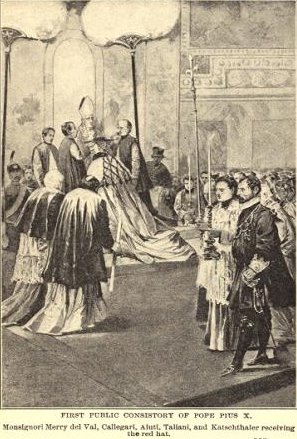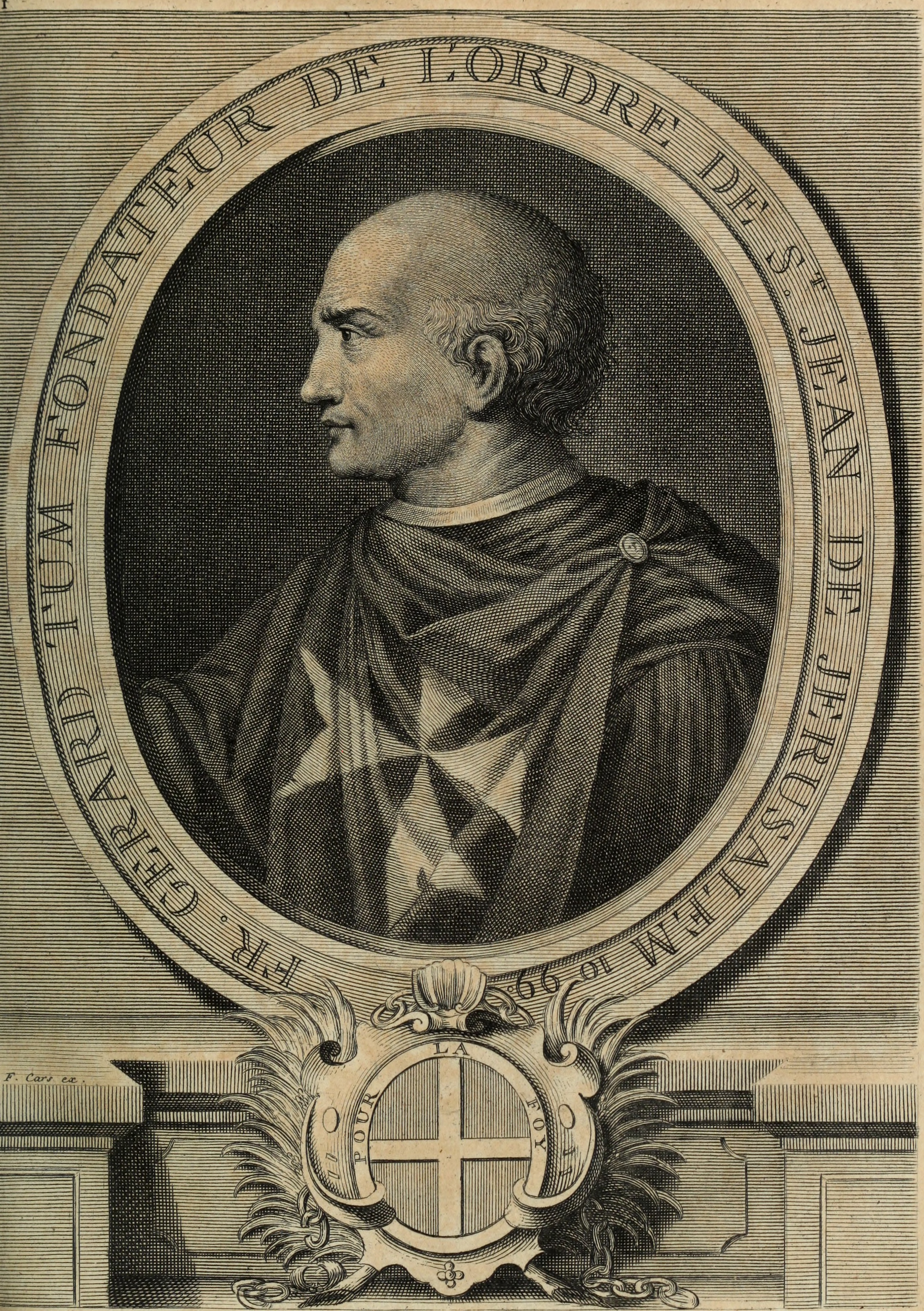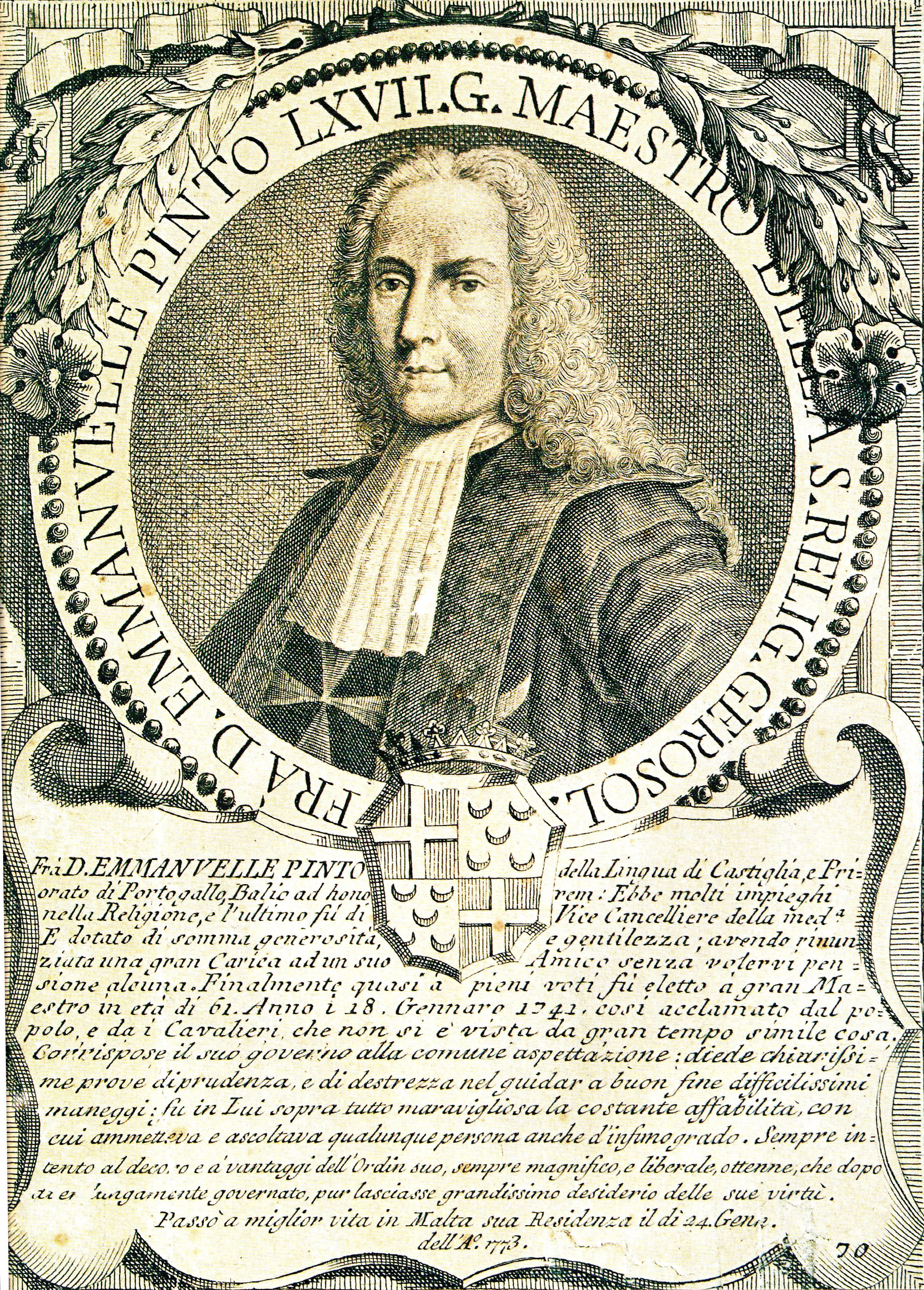|
Ludovico Valenti
Ludovico Valenti (27 April 1695 in Trevi, Umbria – 18 October 1763 in Rome) was an Italian nobleman, ecclesiastical lawyer, papal bureaucrat, Cardinal, and Bishop of Rimini. Family and Youth Ludovico was the son of Alessandro Valenti and Paolina Venturelli. He had two siblings, Gaetano and Gaetana. His uncle Ferdinando was a Consistorial Advocate (lawyer practicing in the ecclesiastical courts of the Roman Curia). A distant relative was Cardinal Erminio Valenti (1564-1618), Bishop of Faenza, who had also had a career as an ecclesiastical lawyer. Benedetto Valenti was a scholar and canon lawyer under popes Clement VII and Paul III. Legal career He pursued legal studies at the University of Rome, La Sapienza, obtaining a doctorate in utroque iure on 20 March 1719. He began a career as a lawyer by serving as a coadjutor (assistant) to his uncle Ferdinando, the Consistorial Advocate. At the Conclave of 31 March-8 May 1721, he was appointed Commissary by the Cardinal Camerlengo ... [...More Info...] [...Related Items...] OR: [Wikipedia] [Google] [Baidu] |
Cardinal (Catholicism)
A cardinal is a senior member of the clergy of the Catholic Church. As titular members of the clergy of the Diocese of Rome, they serve as advisors to the pope, who is the bishop of Rome and the Head of the Church#Catholic Church, visible head of the worldwide Catholic Church. Cardinals are chosen and formally created by the pope, and typically hold the title for life. Collectively, they constitute the College of Cardinals. The most solemn responsibility of the cardinals is to elect a new pope in a Papal conclave, conclave, almost always from among themselves, with a few historical exceptions, when the Holy See is Sede vacante#Vacancy of the Holy See, vacant. During the period between a pope's death or resignation and the election of his successor, the day-to-day governance of the Holy See is in the hands of the College of Cardinals. The right to participate in a conclave is limited to cardinals who have not reached the age of 80 years by the day the vacancy occurs. With the pope ... [...More Info...] [...Related Items...] OR: [Wikipedia] [Google] [Baidu] |
Pope Benedict XIV
Pope Benedict XIV (; ; 31 March 1675 – 3 May 1758), born Prospero Lorenzo Lambertini, was head of the Catholic Church and ruler of the Papal States from 17 August 1740 to his death in May 1758. Pope Benedict X (1058–1059) is now considered an antipope. At the time, however, this status was not recognized by church historians, and so the tenth legitimate pontiff by this name is the one who took the official name Benedict XI (1303–1304). This has advanced the numbering of all subsequent Popes Benedict by one. Popes Benedict XI–XVI are therefore the tenth through fifteenth popes by that name. Perhaps one of the best scholars to sit on the papal throne, yet often overlooked, he promoted scientific learning, the Baroque arts, reinvigoration of Thomism, and the study of the human form. Firmly committed to carrying out the decrees of the Council of Trent and authentic Catholic teaching, Benedict removed changes previously made to the Breviary, sought peacefully to ... [...More Info...] [...Related Items...] OR: [Wikipedia] [Google] [Baidu] |
18th-century Italian Cardinals
The 18th century lasted from 1 January 1701 (represented by the Roman numerals MDCCI) to 31 December 1800 (MDCCC). During the 18th century, elements of Enlightenment thinking culminated in the Atlantic Revolutions. Revolutions began to challenge the legitimacy of monarchical and aristocratic power structures. The Industrial Revolution began mid-century, leading to radical changes in human society and the environment. The European colonization of the Americas and other parts of the world intensified and associated mass migrations of people grew in size as part of the Age of Sail. During the century, slave trading expanded across the shores of the Atlantic Ocean, while declining in Russia and China. Western historians have occasionally defined the 18th century otherwise for the purposes of their work. For example, the "short" 18th century may be defined as 1715–1789, denoting the period of time between the death of Louis XIV of France and the start of the French Revolut ... [...More Info...] [...Related Items...] OR: [Wikipedia] [Google] [Baidu] |
Sant'Andrea Delle Fratte
Sant'Andrea delle Fratte ("Saint Andrew of the Thickets") is a 17th-century basilica church in Rome, Italy, dedicated to St. Andrew. The Cardinal Priest of the ''Titulus S. Andreae Apostoli de Hortis'' is Ennio Antonelli. History The current church was built over a pre-existing one, erected in 1192, called ''infra hortes'' ("amidst the orchards", whence the name ''fratte'', "thickets", from Byzantine Greek , , "hedge") for it was located in a countryside area on the northern edge of the inhabited area of medieval Rome. The church originally belonged to Augustinian nuns. It became the national church of the Scottish people in Rome, until Scotland became Protestant, when in 1585 Pope Sixtus V assigned it to the Minim friars of Saint Francis of Paola. The Scots College, the seminary for young men studying for the priesthood, was located nearby, on the Via del Tritone, until 1604, when it moved to the Via delle Quattro Fontane. In 1942 Pope Pius XII elevated the church to the rank ... [...More Info...] [...Related Items...] OR: [Wikipedia] [Google] [Baidu] |
Camaldolese
The Camaldolese Hermits of Mount Corona () are a Catholic Church, Catholic monastic order of pontifical right for men founded by Romuald, St. Romuald. Its name is derived from the Holy Hermitage () in Camaldoli, high in the mountains of Tuscany, Tuscany, Italy, near the city of Arezzo. Members of that community add the postnominal letters ECMC after their names. A second community, the Benedictine Camaldolese, are also based at Camaldoli and add the postnominals OSB Cam. Apart from the Catholic monasteries, ecumenical Christian hermitages with a Camaldolese spirituality have arisen as well. History The Camaldolese were established through the efforts of the Italian people, Italian monk Saint Romuald (). His reform sought to renew and integrate the hermit, eremitical tradition of monastic life with that of the cenobium. In his youth, Romuald became acquainted with the three major schools of Western monastic tradition. The monastery where he first entered monastic life, Basilica ... [...More Info...] [...Related Items...] OR: [Wikipedia] [Google] [Baidu] |
Santa Susanna
The Church of Saint Susanna at the Baths of Diocletian () is a Roman Catholic, Catholic parish church, parish and Cistercian conventual church located on the Quirinal Hill in Rome, Italy. There has been a titular church associated to its site as far back as AD 280. The current church was rebuilt between 1585 and 1603 for a community of Cistercian nuns founded on the site in 1587 and still based there. The church served as the national parish for residents of Rome from the United States from 1921 to 2017, during which period the pastoral work of the parish was assigned to the Paulist Fathers, a society of priests founded in the United States. The Paulist Fathers' ministry to United States Catholics subsequently moved to San Patrizio (Saint Patrick). Architectural history Roman era About AD 280, an early Christian house of worship was established on this site, which, like many of the earliest Christian meeting places, was in a house (''domus ecclesiae''). According to the 6th-centu ... [...More Info...] [...Related Items...] OR: [Wikipedia] [Google] [Baidu] |
Papal Consistory
In the Catholic Church, a consistory is a formal meeting of the College of Cardinals called by the pope. There are two kinds of consistories, extraordinary and ordinary. An "extraordinary" consistory is held to allow the pope to consult with the entire membership of the College of Cardinals. An "ordinary" consistory is ceremonial in nature and is normally attended by cardinals resident in Rome. For example, the pope elevates new cardinals to the College at a consistory; Pope Francis called consistories for ceremonies of canonization; and Pope Benedict announced his decision to retire in 2013 at a consistory. A meeting of the College of Cardinals to elect a new pope is not a consistory, but a conclave. History The term ''consistory'' comes from the ; "stand together".''Papal Consistory'' by Kevin Knight (Catholic Encyclopedia, 2009) ... [...More Info...] [...Related Items...] OR: [Wikipedia] [Google] [Baidu] |
Canonization
Canonization is the declaration of a deceased person as an officially recognized saint, specifically, the official act of a Christianity, Christian communion declaring a person worthy of public veneration and entering their name in the canon catalogue of saints, or authorized list of that communion's recognized saints. Catholic Church Canonization is a Pope, papal declaration that the Catholic Church, Catholic faithful may Veneration, venerate a particular deceased member of the church. Popes began making such decrees in the tenth century. Up to that point, the local bishops governed the veneration of holy men and women within their own dioceses; and there may have been, for any particular saint, no formal decree at all. In subsequent centuries, the procedures became increasingly regularized and the Popes began restricting to themselves the right to declare someone a Catholic saint. In contemporary usage, the term is understood to refer to the act by which any Christianity, Ch ... [...More Info...] [...Related Items...] OR: [Wikipedia] [Google] [Baidu] |
Joseph Of Cupertino
Joseph of Cupertino (Copertino), OFM Conv. (; 17 June 1603 – 18 September 1663) was an Italian Conventual Franciscan friar who is honored as a Christian mystic and saint. According to traditional Franciscan accounts, he was "remarkably unclever", but experienced miraculous levitation and ecstatic visions throughout his life which made him the object of scorn. He applied to the Conventual Franciscan friars, but was rejected due to his lack of education. He then pleaded with them to serve in their stables. After several years of working there, he had impressed the friars so much with the devotion and simplicity of his life that he was admitted to their Order, destined to become a Catholic priest, in 1625. Life He was born the son of Felice Desa and Frencesca Panaca in the village of Cupertino, in the Region of Apulia, then in the Kingdom of Naples, now in the Italian Province of Lecce. His father having died before his birth, however, the family home was seized to settle th ... [...More Info...] [...Related Items...] OR: [Wikipedia] [Google] [Baidu] |
Sovereign Military Order Of Malta
The Sovereign Military Order of Malta (SMOM), officially the Sovereign Military Hospitaller Order of Saint John of Jerusalem, of Rhodes and of Malta, and commonly known as the Order of Malta or the Knights of Malta, is a Catholic lay religious order, traditionally of a military, chivalric, and noble nature. Though it possesses no territory, the order is often considered a sovereign entity under international law. The Order traces its institutional continuity with the Knights Hospitaller, a chivalric order that was founded about 1099 by the Blessed Gerard in the Kingdom of Jerusalem. The order is led by an elected prince and grand master. Its motto is ("Defence of the faith and assistance to the poor"). The government of the Sovereign Order of Malta has a similar structure to state governments. However, it also includes specific features associated with its nature as a lay religious order, as well as particular terminology evolved from nine centuries of history. The ... [...More Info...] [...Related Items...] OR: [Wikipedia] [Google] [Baidu] |
List Of Princes And Grand Masters Of The Sovereign Military Order Of Malta
This is a list of grand masters of the Knights Hospitaller, including its continuation as the Sovereign Military Order of Malta after 1798. It also includes unrecognized "anti-grand masters" and lieutenants or stewards during vacancies. In lists of the heads of the Order, the title "grand master" is often applied retrospectively to the early heads of the Order. The medieval heads of the Order used the title of ''custos'' (guardian) of the hospital. The title ''magister'' (master) is used on coins minted in Rhodes, beginning with Foulques de Villaret. The first to use the title ''grandis magister'' (grand master) was Jean de Lastic (reigned 1437–1454). Later grand masters in Rhodes used ''magnus magister'' (grand master). In 1607 Holy Roman Emperor Rudolf II created the grand master a prince of the Holy Roman Empire (''Reichsfürst'').''Gothaisches Genealogisches Handbuch des Fürstlichen Häuser'', Fürstliche Häuser Band 2 (Marburg: Verlag des Deutschen Adelsarchivs, 2018 ... [...More Info...] [...Related Items...] OR: [Wikipedia] [Google] [Baidu] |
Manuel Pinto Da Fonseca
Manuel Pinto da Fonseca (also ''Emmanuel Pinto de Fonseca''; 24 May 1681 – 23 January 1773) was a Portuguese nobleman, the 68th Grand Master of the Order of Saint John, from 1741 until his death. He undertook many building projects, introducing the Baroque style throughout Malta. The cost of these projects contributed to bankrupting the Order in the decades following his death. His views were comparatively liberal. In 1764, he agreed to the re-unification with the Protestant Prussian branch of the Order, without, however, receiving the approval of Pope Clement XIII. The pope did agree, reluctantly, to the expulsion of the Jesuits from Malta in 1768. Biography He was the son of Miguel Álvaro Pinto da Fonseca, '' Alcaide-Mór'' de Ranhados, and his wife, Ana Pinto Teixeira. The coat of arms of the Pinto portrays five red crescents, to symbolising that the Pinto de Fonseca family won five battles with the Ottomans. Before his election as Grand Master on 18 January 1741, ... [...More Info...] [...Related Items...] OR: [Wikipedia] [Google] [Baidu] |






